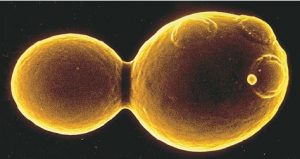Reproduction in Fungi/Microbiology Subjective notes for BPharm/MCQs for GPAT and NIPER
REPRODUCTION IN FUNGI
All the perfect fungi can reproduce sexually as well as asexually, but fungi imperfecti can only reproduce asexually. In sexual as well as in asexual reproduction, fungi forms spores, which are very light in weight and can be dispersed with the help of wind, water or animals.
Asexual reproduction
Majority of fungi reproduce asexually through formation of spores. While, some fungi can also reproduce asexually through budding and fragmentation. In fragmentation, mycelium is fragmented into pieces and each piece can grow into separate mycelium. Whereas, in budding, a bulge is formed on the side of the cell of fungi and nucleus divides mitotically. At the end, the bud detaches itself from the parent cell and can grow as an independent organism.
Fig: Budding in Yeast
The above image is taken only for educational purpose from [1]
Formation of spores during asexual reproduction includes mitosis divisions in which only one parent is required. Different types of spores can be produced by the fungi. Conidiospores are unicellular or multicellular and are released directly from the tip of the hypha. Sporangiospores are the spores produced in the sporangium. In the process of fragmentation, hypha forms unicellular cells which are then released in environment in form of spores. Individual grown from asexual spores are genetically identical to the parent organism.
Sexual reproduction
Sexual reproduction can only occur in the perfect fungi, while fungi imperfecti cannot exhibit sexual reproduction. In sexual reproduction, two mating types are required. Homothallic or self-fertile organisms have presence of both mating types on the same mycelium, heterothallic have presence of only one type of mating type in the mycelium and required two different types of mating times, which are compatible to reproduce sexually.
There are variations in the process of sexual reproduction in each class of fungi, but sexual reproduction in fungi include three common stages. They are:
- Plasmogamy: In this, two haploid cells fuse together or there is union of the cytoplasm of two haploid cells. This results in the formation of a dikaryotic cell, in which, two haploid nuclei exist in the same cell.
- Karyogamy: In this stage, two haploid nuclei fuse together to give rise to a diploid zygote.
- Meiosis: Within the gametangia, gametes of different mating types are generated. These in the form of spores are disseminated into the environment.
Fig: Life cycle of a fungi
The above image is taken only for educational purpose from [1]
The life cycle of a typical perfect fingi can be understand by the example of life cycle of ascomycota class members. It involves:
i. It starts from haploid organism (N+N)
ii. Karyogamy which is the fusion of nuclei to produce diploid organism (2N)
iii. Meisos results in the formation of 8 ascospores in the ascus.
iv. Ascospores are released in environment which though mitosis, udergoes asexual reproduction and produces Male and Female strains separately.
v. Anthredium (male) and Archegonium (female) undergoes Cytoplasmic fusion (Karyogamy) to form the haploid organism known as Ascocarp.
Fig: Life cycle of ascomycota class members
The above image is taken only for educational purpose from [1]
MCQs
1. Number of parents required during formation of spores in fungi during asexual reproduction is?
a. 1
b. 2
c. 3
d. 4
2. Reproduction in fungi can be through?
a. Asexual reproduction only
b. Sexual reproduction only
c. Both sexual and asexual reproduction in all the classes of fungi
d. Asexual reproduction and sexual in most of the fungi
3. Sexual reproduction is not found in which class of fungi?
a. Ascomycota
b. Zygomycota
c. Basidiomycota
d. None of the above
4. Type of spore formed during asexual stage of Ascomycota is called?
a. Conidia
b. Ascospores
c. Zygospores
d. Basidia
5. Deuteromycota class is also called as ‘Fungi Imperfecti’ as?
a. Hyphae is absent in them
b. They cannot move
c. Sexual reproduction is absent in them
d. They are non-pathogenic to human
6. Number of ascospores present in one ascus after completion of miosis is?
a. 1
b. 2
c. 4
d. 8
7. Correct sequence for the sexual cycle of fungi starting from the haploid organism can be?
I. Plasmogamy
II. Karyogamy
III. Miosis
IV. Mitosis
a. I – II – III
b. I – II – IV
c. IV – III – I
d. III – I – II
Participate in Online FREE GPAT TEST: CLICK HERE
Participate in Online FREE Pharmacist TEST: CLICK HERE
Participate in Online FREE Drug Inspector TEST: CLICK HERE
Participate in CSIR NET JRF Mock Test
ANSWERS
1-a
2-d
3-d
4-a
5-c
6-d
7-a
RFERENCES
[1] Black JG, Black LJ. Microbiology: principles and explorations. John Wiley & Sons; 2018 Jan 4.

